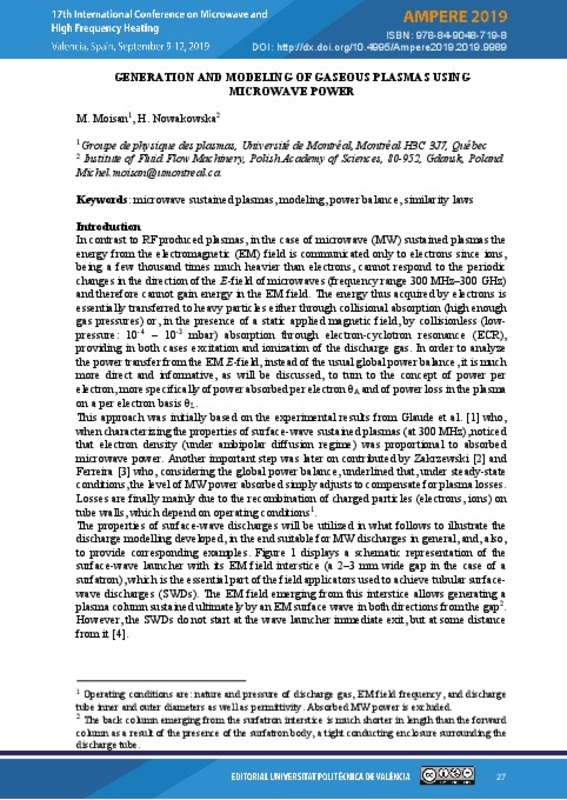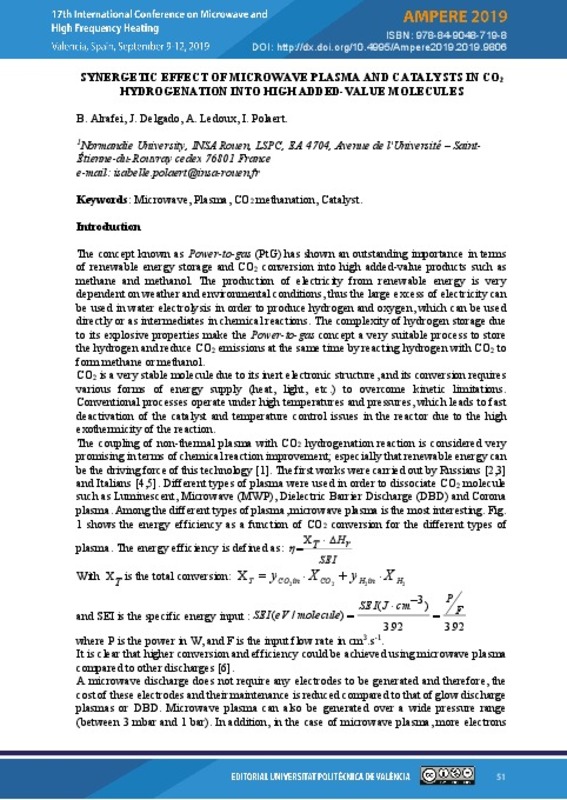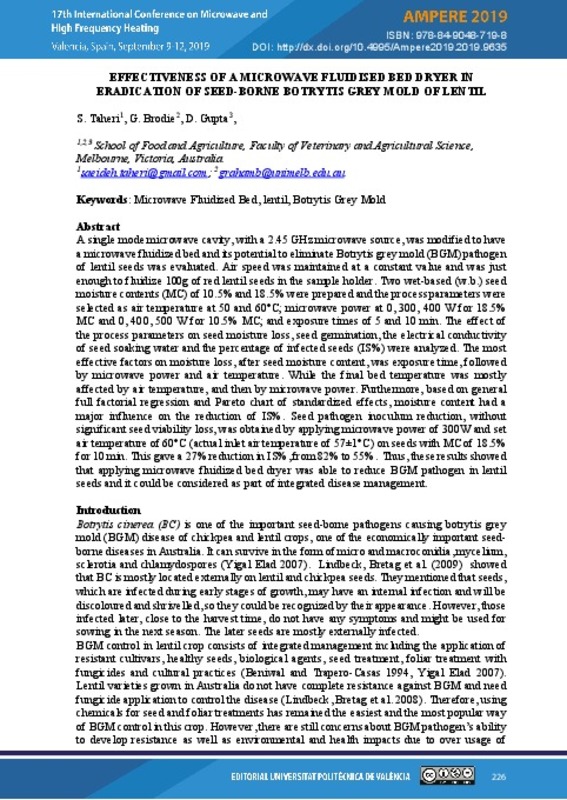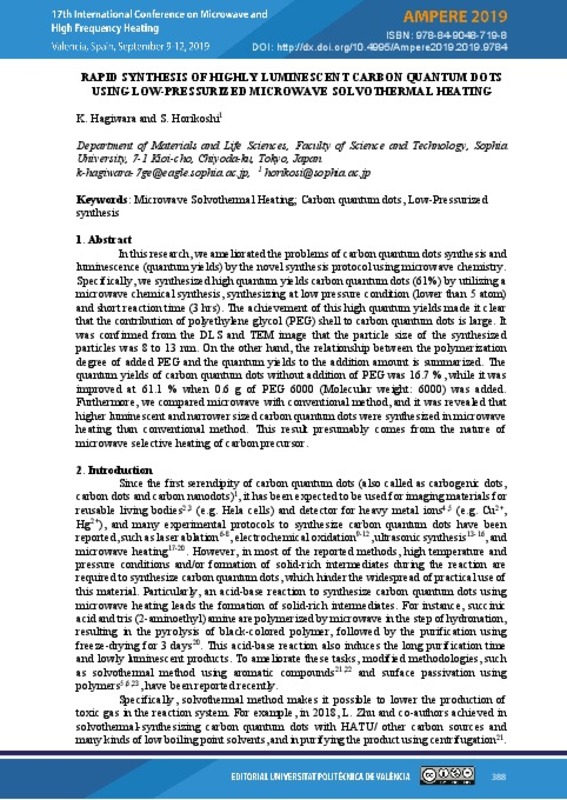JavaScript is disabled for your browser. Some features of this site may not work without it.
Buscar en RiuNet
Listar
Mi cuenta
Estadísticas
Ayuda RiuNet
Admin. UPV
Generation and modeling of gaseous plasmas using microwave (MW) power
Mostrar el registro sencillo del ítem
Ficheros en el ítem
| dc.contributor.author | Moisan, Michel
|
es_ES |
| dc.contributor.author | Nowakowska, H.
|
es_ES |
| dc.date.accessioned | 2019-11-11T13:06:41Z | |
| dc.date.available | 2019-11-11T13:06:41Z | |
| dc.date.issued | 2019-10-15 | |
| dc.identifier.isbn | 9788490487198 | |
| dc.identifier.uri | http://hdl.handle.net/10251/130714 | |
| dc.description.abstract | [EN] In contrast to RF produced plasmas, in the case of microwave plasmas the energy from the electromagnetic (EM) field is communicated only to electrons since ions, being a few thousand times much heavier than electrons, cannot respond to the periodic changes in the direction of the E-field of microwaves (typical frequency range 100 MHz-300 GHz) and therefore cannot gain energy in the EM field. The energy of electrons is essentially transferred to heavy particles either through numerous enough collisions during the E-field period (high enough gas pressures) or through electron-cyclotron resonance (pressures below mTorr) sustaining in this way the gas discharge. This had led to introduce the concept of power absorbed per electron qA and power loss on a per electron basis qL [1]. Under steady-state conditions and when the plasma volume (the volume in which plasma particles recombine and, thus, power is lost) is equal to the volume in which power is absorbed from the MW field, we have the power balance qA = qL, which can be shown to be much informative than the usual global power balance. qA is defined as where n is the electron collision frequency for momentum transfer, w, the wave angular frequency, e/me, the electron charge to mass ratio, and , the mean squared value of the EM E-field. The value of qA (absorbed power) is shown to adjust so as to compensate exactly for qL (power losses), which is thus the dominant power parameter; as a result, the intensity of the maintenance E-field sustaining the discharge comes out as an internal parameter, i.e., it is operator-independent, in contrast to what is generally believed whatever the kind of E-field sustained discharges. Other related features are: i) whenever this can be achieved, the smaller the volume in which power is absorbed with respect to the volume in which it is spent, the higher the intensity of the maintenance E-field: this leads to higher atomic (molecular) excitation rates inside than outside the absorption region (such is the case in micro-discharges); ii) an interesting fact as far as understanding RF and MW discharge properties is concerned is that the value of qL decreases with increasing frequency from the RF domain to that of MWs; iii) similarity laws, initially derived with DC discharges, are generalized to include RF and microwave discharges. For example, qA/p as a function of pR (p is gas pressure and R discharge-tube inner radius) replaces advantageously the widely used E/p vs. pR similarity law since qA is more easily measured than E2 and further it avoids considering the latter as an external parameter, etc.; iv) using the power per electron balance, it can be proved that the EM E-field intensity under electron cyclotron resonance (ECR) condition passes through a minimum, not a maximum, contrary to what is generally claimed; v) the E-field intensity under pulsed regime can be maximized under short enough pulse length and long enough off-time in between. | es_ES |
| dc.format.extent | 8 | es_ES |
| dc.language | Inglés | es_ES |
| dc.publisher | Editorial Universitat Politècnica de València | es_ES |
| dc.relation.ispartof | AMPERE 2019. 17th International Conference on Microwave and High Frequency Heating | es_ES |
| dc.rights | Reconocimiento - No comercial - Sin obra derivada (by-nc-nd) | es_ES |
| dc.subject | Energy Production by Microwaves | es_ES |
| dc.subject | Microwave CVD | es_ES |
| dc.subject | EM Modelling | es_ES |
| dc.subject | Microwave Material interaction | es_ES |
| dc.subject | Dielectric Properties | es_ES |
| dc.subject | Dielectric Properties Measurement | es_ES |
| dc.subject | Solid State Microwave | es_ES |
| dc.subject | Microwave Processing | es_ES |
| dc.subject | Microwave Chemistry | es_ES |
| dc.subject | Microwave applicators design | es_ES |
| dc.title | Generation and modeling of gaseous plasmas using microwave (MW) power | es_ES |
| dc.type | Capítulo de libro | es_ES |
| dc.type | Comunicación en congreso | es_ES |
| dc.identifier.doi | 10.4995/AMPERE2019.2019.9989 | |
| dc.rights.accessRights | Abierto | es_ES |
| dc.description.bibliographicCitation | Moisan, M.; Nowakowska, H. (2019). Generation and modeling of gaseous plasmas using microwave (MW) power. En AMPERE 2019. 17th International Conference on Microwave and High Frequency Heating. Editorial Universitat Politècnica de València. 27-34. https://doi.org/10.4995/AMPERE2019.2019.9989 | es_ES |
| dc.description.accrualMethod | OCS | es_ES |
| dc.relation.conferencename | Ampere 2019 | es_ES |
| dc.relation.conferencedate | Septiembre 09-12,2019 | es_ES |
| dc.relation.conferenceplace | Valencia, Spain | es_ES |
| dc.relation.publisherversion | http://ocs.editorial.upv.es/index.php/AMPERE2019/AMPERE2019/paper/view/9989 | es_ES |
| dc.description.upvformatpinicio | 27 | es_ES |
| dc.description.upvformatpfin | 34 | es_ES |
| dc.type.version | info:eu-repo/semantics/publishedVersion | es_ES |
| dc.relation.pasarela | OCS\9989 | es_ES |
Este ítem aparece en la(s) siguiente(s) colección(ones)
-
Ampere 2019 [66]











